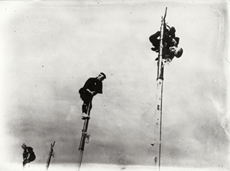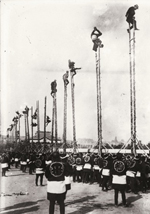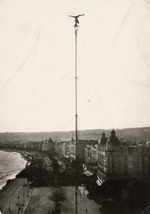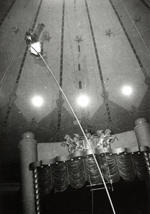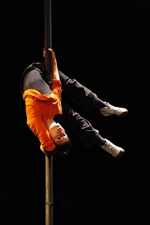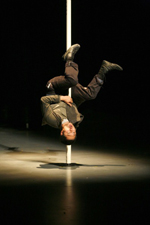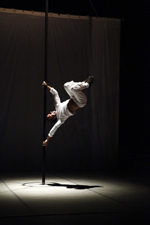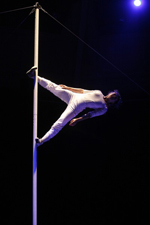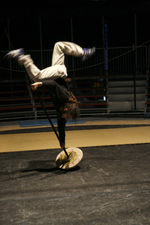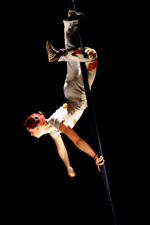by Pascal Jacob and Bruno Krief
Climbing – higher and higher the better to see, catch, observe, gauge danger and protect oneself. The origins of the pole acts are organic, defensive and fun. When evaluating the possibility of climbing up and being higher off the ground when planning to move on, hunter-gatherers used what already existed: promontories, rocky outcrops, and trees, with the latter revealing themselves as the most efficient means of gaining a dominant position. This natural verticality was gradually adapted to the utilitarian and spectacular needs of warriors. Climbing, which was linked to necessary and practical food gathering, gradually became a pretext for playing with the limits of gravity. The most agile and the fastest climbers composed a specific group who continued to try and climb faster and faster to the top of ever-higher trees. This is where the look-out post principle comes from, as do games of agility that use a wooden pole as a base. Gradually, a vital need transformed into an acrobatic pretext before becoming a codified, spectacular discipline mainly associated with Asian populations. Petroglyphs found in the Han Dynasty tomb in Chengdu show acrobats on vertical supports, probably thin trees or bamboo, and a first repertoire of figures was noted in the Theory of 1000 Entertainments by the emperor Wu Di (156-87), in 108 A.D.
Verticality and the group
The vertical aspect of the apparatus leads to climbing up and down, hand or foot holds, shoulder mounts, slides, flags and rolls. This somewhat static language has been enriched by the development of a repertoire of jumps, which have added a dynamic aspect to the work, including single or double pirouettes, forward or backward somersaults, twists transforming into balls, etc. The technique is evolving continually and has transformed in spectacular fashion over the past twenty years. Chinese and North Korean companies have always preferred group work, based on momentum and synchronisation complicated by lifts, but as the act became a more individual discipline, mainly in the west, fluid sequences took the place of what was for a long time, a pure demonstration, sometimes even with a military connotation. A great classic in the genre is the "sailors act" where, against a simple, old-fashioned backdrop in which the poles represent the hypothetical masts of a ship's sails, one to two dozen acrobats perform positions and jumps moving from one pole to another. The Hacuna Matata company, trained at the Dar Es Salaam acrobatics school, combine Chinese rigour with African street energy in a blend reminiscent of the Compania Havana de Cuba. When incorporated into programmes in European schools, the perception of poles, previously seen as an amusing take on the fireman's pole, changed, as did their identity. As a solo, duo or trio act, the Chinese pole is now a pretext for acrobatic and choreographic variations that see regular technical improvements. Vertical Tango, a duo created in the mid 2000s, elegantly illustrates the fusion between a dance form and acrobatics.
Swaying pole
Whether made from simple bamboo, or from wood, steel, aluminium or carbon fibre, the pole has known many guises and continues to be adapted depending on what acrobats want to express, or depending on its contribution in terms of dramatic art. In 2005, Joao Peirera dos Santos, trained at the Centre National des Arts du Cirque in Châlons-en-Champagne, created Peut être, a monodisciplinary form based on the Chinese pole, establishing a unique style that saw him combine strength with exceptionally high quality movements. The Mâtitube, by Christophe Huysman, with William Valet, Sylvain Decure, Antoine Raimondi and Tsirihaka Harrivel, is both a stage proposition for an urban space, and a beautiful reflection on the axes and balance demonstrated by a powerful acrobat.
Hand-holds, crawling and ascension techniques more or less constitute the genetic code of the discipline and have, since the 19th century, been subject to variations based on the shared problematic of verticality. Oscillating poles were very fashionable in the early 20th century, mainly in Switzerland, where the Nock and Bauer families made it their speciality. There is an enduring memory of Bello Nock, a polyvalent artist whose clown act did not reject that which made his ancestors glorious. The interaction around swaying was made popular by Fattini in the 1950s, when he feigned drunkenness clinging on to an elongated streetlamp, creating almost by default, a new balance technique based on an impressive range of motion. Today, the Australian company, Strange Fruit, plant their poles in city centres, providing unusual choreographies performed to the rhythm of the music and the wind.
Technical developments
The flying or swinging pole is another variation on the theme of frustrated verticality and a source of unforeseen constraints. When Foucauld Falguerolles created a flying pole whose movements were adjusted by the human counterweight, he joined the natural lineage of Edouard Doyle's and Maud Ambroise's swinging poles, and Alix Bouyssie's curved barre. Saulo Sarmiento developed similar work with a hanging pole, another way of apprehending verticality and random oscillation, but also a subtle way of playing with an extremely simple apparatus, transcended by its new orientation.
The technique was performed as a gyrating trio by the Arts des Airs company in 2007 for the Vertige de l’ombre show. This use of the apparatus is a source of inspiration for many young artists, and reveals its malleability and intensity. The French company, Mauvais Coton, invented a culbuto pole for Vol du rampart, an alternative interpretation of the balancing pole, while Marianne-Michel developed a choreographic work based on the classical pole. The importance of transitions, and the implementation of new compositions based on fluid, gliding movements constructed from releases and rotations, founded the contemporary approach, indicating a period of continual reinterpretation for this ancient discipline.



